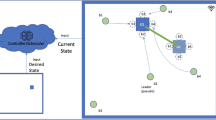Abstract
This paper deals with an approach for resolving deadlock problems in the case of carrying loads by the Distributed Autonomous Robotic System (DARS). The deadblock condition appears in multiple robots which move and work autonomously. Therefore, we propose an algorithm to resolve the deadlock condition by cooperative hand-to-hand motion, which is a type of cooperative performance. This paper shows the effectiveness of hand-to-hand motion through numerical simulation.
Similar content being viewed by others
References
Wang J, Premvuti S (1994) Fully distributed traffic regulation and control for multiple autonomous mobile robots operating in discrete space. Proc of Int Symp on Distributed Autonomous Robotic Systems (DARS'94), pp. 134–141
Brooks RA (1986) A robust layered control system for a mobile robot. IEEE J Robotics Automation RA-2 (1):14–23
Parker LE (1993) Designing control laws for cooperative agent teams. Proc of Int Conf on Robotics and Automation (ICRA'93), pp 583–587
Agah A, Bekey GA (1994) A novel cognate architecture for simulated robots in an artificial world, Proc ICRA'94, pp 2309–2314
Hara F, Ichikawa S (1992) Effects of population size in multirobots cooperative behaviors, Proc DARS'92, pp 3–9
Ohmori Y, Nakauchi Y, Anzai Y (1992), Task allocation algorithm for cooperation of distributed autonomous mobile robots, Proc DARS'92, pp 159–165
Wang J (1994) On sign-board based inter-robot communication in distributed robotic systems, Proc ICRA'94, pp 1045–1050
Fukuda T, Ueyama T (1994) Cellular robotics and micro robotic systems. World scientific series in robotic and automated systems, vol 10, World Scientific, pp 1–47
Fukuda T (1989) Structure descision method for self organizing robots based on cell structure-CEBOT. Proc ICRA'89, pp 695–700
Fukuda T et al. (1989) Communication Method of cellular robotics CEBOT as a self-organizing robotic system, Proc Int Workshop on Intelligent Robots and System'89 (IROS'89), pp 291–296
Fukuda T et al. (1992) Concept of cellular robotic system (CEBOT) and basic strategies for its realization, Comput Electr Eng 18(2):11–39
Fukuda T et al. (1994) Optimization of group behavior on cellular robotic system in dynamic environment. Proc. ICRA'94, pp 1027–1032
Cai AH et al. (1995) Hierarchical control architecture for cellular robotic system—simulations and experiments. Proc ICRA'95, pp 1191–1196
Matsumoto A et al. (1990) Communication in the autonomous and decentralized robot system ACTRESS, Proc IROS'90, pp 835–840
Yuta S, Premvuti S (1992) Coordinating autonomous and centralized decision making to achieve cooperative behaviors between multiple mobile robots, Proc DARS'92, pp 173–181
Wang J (1992) Deadlock detection and resolution in distributed robotic system, Proc DARS'92, pp 93–101
Author information
Authors and Affiliations
Corresponding author
About this article
Cite this article
Isihara, H., Fukuda, T. & Hiraoka, N. Deadlock resolution using hand-to-hand motion. Artificial Life and Robotics 1, 197–203 (1997). https://doi.org/10.1007/BF02471140
Received:
Accepted:
Issue Date:
DOI: https://doi.org/10.1007/BF02471140



